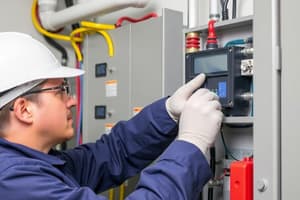Podcast
Questions and Answers
What is the main responsibility of the supervisor regarding OHE inspections?
What is the main responsibility of the supervisor regarding OHE inspections?
- Inspect only when defects are reported
- Cover the entire section once every three months (correct)
- Supervise only when maintenance is scheduled
- Conduct inspections once a year
Which of the following actions must a supervisor take if defects are reported?
Which of the following actions must a supervisor take if defects are reported?
- Wait for the next inspection to address them
- Ignore them if they are minor
- Only report them to his superior officers
- Scrutinize the reports and arrange prompt rectification (correct)
How often should a supervisor's section gangs be checked for quality work?
How often should a supervisor's section gangs be checked for quality work?
- Only during emergencies
- Weekly
- Periodically, as per prescribed schedules (correct)
- Bi-weekly
What should a supervisor do regarding training for his staff?
What should a supervisor do regarding training for his staff?
What is necessary for the maintenance of OHE tools and equipment?
What is necessary for the maintenance of OHE tools and equipment?
In case of a breakdown, what is the responsibility of the supervisor?
In case of a breakdown, what is the responsibility of the supervisor?
How should a supervisor handle spare parts and maintenance stores?
How should a supervisor handle spare parts and maintenance stores?
What is strictly forbidden when making joints in a conductor?
What is strictly forbidden when making joints in a conductor?
What should be done to the transformer before starting any work on it?
What should be done to the transformer before starting any work on it?
When can work on overhead lines running parallel to electrified tracks be performed without switching off power from the 25 kV traction line?
When can work on overhead lines running parallel to electrified tracks be performed without switching off power from the 25 kV traction line?
What is the minimum tensile strength requirement for temporary anchoring of conductors?
What is the minimum tensile strength requirement for temporary anchoring of conductors?
What should be maintained in proper condition regarding structure bonds?
What should be maintained in proper condition regarding structure bonds?
What should be done with the removed fittings after replacing 100 percent OHE fittings in tunnels?
What should be done with the removed fittings after replacing 100 percent OHE fittings in tunnels?
During the inspection of wires for overhead cross-feeders, which issues should be specifically checked?
During the inspection of wires for overhead cross-feeders, which issues should be specifically checked?
What should be done to ensure proper maintenance of insulators during inspections?
What should be done to ensure proper maintenance of insulators during inspections?
What action should be taken for fittings that do not provide the prescribed margin of adjustment during POH?
What action should be taken for fittings that do not provide the prescribed margin of adjustment during POH?
What should be done before tightening PG clamps during inspection?
What should be done before tightening PG clamps during inspection?
What is the recommended approach if a major OHE breakdown occurs?
What is the recommended approach if a major OHE breakdown occurs?
What should be inspected regarding aluminum bronze fittings during workshop maintenance?
What should be inspected regarding aluminum bronze fittings during workshop maintenance?
What action should be taken if G.I. fittings show signs of deterioration during inspections?
What action should be taken if G.I. fittings show signs of deterioration during inspections?
What is the first action to take when checking turnouts?
What is the first action to take when checking turnouts?
During maintenance, how should rubber washers/rings be treated?
During maintenance, how should rubber washers/rings be treated?
What should be done when the guide pulley is damaged?
What should be done when the guide pulley is damaged?
Which of the following defects can lead to obstruction of the movable pulley?
Which of the following defects can lead to obstruction of the movable pulley?
How often should regulating equipment be overhauled?
How often should regulating equipment be overhauled?
What is the purpose of the stop nuts on the guide rods?
What is the purpose of the stop nuts on the guide rods?
What should be used to check the integrity of stainless steel ropes?
What should be used to check the integrity of stainless steel ropes?
What temperature can the approved grease withstand without drying?
What temperature can the approved grease withstand without drying?
What is an indicator that the regulating equipment needs to be overhauled?
What is an indicator that the regulating equipment needs to be overhauled?
What defect is NOT manageable in-situ?
What defect is NOT manageable in-situ?
What is affected by the shape and dimensions of the winch frame arms?
What is affected by the shape and dimensions of the winch frame arms?
What is the maximum speed allowed for the OHE Inspection Car when checking contact wire level and stagger?
What is the maximum speed allowed for the OHE Inspection Car when checking contact wire level and stagger?
What should be done to the pantograph before starting any operation for checking OHE?
What should be done to the pantograph before starting any operation for checking OHE?
Who is responsible for ensuring the safety of the section before someone goes up on the roof of the OHE Inspection Car?
Who is responsible for ensuring the safety of the section before someone goes up on the roof of the OHE Inspection Car?
Under what condition can the OHE inspection car operate with the pantograph raised?
Under what condition can the OHE inspection car operate with the pantograph raised?
What is the procedure for the OHE Inspection Car when approaching turnouts and cross overs?
What is the procedure for the OHE Inspection Car when approaching turnouts and cross overs?
What should be done to the pantograph when not in use?
What should be done to the pantograph when not in use?
How many OHE staff need to be trained to drive the OHE Inspection Car in emergencies?
How many OHE staff need to be trained to drive the OHE Inspection Car in emergencies?
Which condition is NOT allowed for the operation of the OHE Inspection Car?
Which condition is NOT allowed for the operation of the OHE Inspection Car?
What should be used instead of strings or cords to clamp the pantograph securely?
What should be used instead of strings or cords to clamp the pantograph securely?
What is prohibited when driving the OHE Inspection Car for checking operations?
What is prohibited when driving the OHE Inspection Car for checking operations?
What is the primary responsibility of a linesman during patrol work on OHE?
What is the primary responsibility of a linesman during patrol work on OHE?
Which method is recommended to check if OHE masts are out of plumb?
Which method is recommended to check if OHE masts are out of plumb?
What is a critical action linesmen should take if they notice erosion near OHE masts?
What is a critical action linesmen should take if they notice erosion near OHE masts?
Which approach is essential for maintaining traction assets in service?
Which approach is essential for maintaining traction assets in service?
During the assessment of masts, what should be measured to determine their deflection?
During the assessment of masts, what should be measured to determine their deflection?
What should linesmen develop the ability to do in the event of OHE breakdowns?
What should linesmen develop the ability to do in the event of OHE breakdowns?
What should be taken into account while defining the preventive maintenance schedule?
What should be taken into account while defining the preventive maintenance schedule?
What is the purpose of utilizing a ratchet screw adjustment on a micrometer when measuring contact wire thickness?
What is the purpose of utilizing a ratchet screw adjustment on a micrometer when measuring contact wire thickness?
How should the location for measuring contact wire thickness be identified for consistency in future measurements?
How should the location for measuring contact wire thickness be identified for consistency in future measurements?
What action must be taken if the contact wire reaches the condemning limit of thickness?
What action must be taken if the contact wire reaches the condemning limit of thickness?
What is the maximum number of splices allowed in one tension length according to the given standards?
What is the maximum number of splices allowed in one tension length according to the given standards?
Which material is commonly used for the main components of splice fittings in OHE equipment?
Which material is commonly used for the main components of splice fittings in OHE equipment?
What testing must samples of splice fittings undergo in addition to normal quality tests?
What testing must samples of splice fittings undergo in addition to normal quality tests?
What is the minimum distance a splice should be located from a support in the direction of traffic?
What is the minimum distance a splice should be located from a support in the direction of traffic?
In new constructions, what is the general rule regarding splice usage?
In new constructions, what is the general rule regarding splice usage?
What is the preferred distance between adjacent splices according to guidelines?
What is the preferred distance between adjacent splices according to guidelines?
What should be done if more than two sheds are broken on an insulator?
What should be done if more than two sheds are broken on an insulator?
Which step is required when checking the condition of droppers?
Which step is required when checking the condition of droppers?
What is the maximum stagger allowed at the turn cuts for Overhead Equipment (OHE)?
What is the maximum stagger allowed at the turn cuts for Overhead Equipment (OHE)?
What should be done with galvanized pipes that show chipped galvanization?
What should be done with galvanized pipes that show chipped galvanization?
What action is necessary for muffs that are cracked or damaged?
What action is necessary for muffs that are cracked or damaged?
During inspections, what should be checked regarding the contact and catenary wires?
During inspections, what should be checked regarding the contact and catenary wires?
What should be done if PG clamps and jumpers show signs of wear?
What should be done if PG clamps and jumpers show signs of wear?
What is required for the inspection of caution notice boards and number plates?
What is required for the inspection of caution notice boards and number plates?
What action should be taken if components in cantilever assemblies show signs of overheating?
What action should be taken if components in cantilever assemblies show signs of overheating?
What should be done if any stranded conductor has more than 20% of its strands broken?
What should be done if any stranded conductor has more than 20% of its strands broken?
When checking the heights and staggers, what is essential regarding coordination?
When checking the heights and staggers, what is essential regarding coordination?
During the maintenance of contact wires, which tool should be avoided for cleaning grooves?
During the maintenance of contact wires, which tool should be avoided for cleaning grooves?
What is the key consideration when checking the position of the contact wire relative to tracks?
What is the key consideration when checking the position of the contact wire relative to tracks?
What is the purpose of the maintenance charts that may be prepared in different colors?
What is the purpose of the maintenance charts that may be prepared in different colors?
All regulating equipment must be replaced with what type of equipment?
All regulating equipment must be replaced with what type of equipment?
When performing POH, what should be done with the brackets of cantilever assemblies in relation to the mast axis?
When performing POH, what should be done with the brackets of cantilever assemblies in relation to the mast axis?
What should be ensured regarding the insulators of anchoring wires during inspections?
What should be ensured regarding the insulators of anchoring wires during inspections?
What is the recommended action if kinks are observed in the conductors during maintenance?
What is the recommended action if kinks are observed in the conductors during maintenance?
Which of the following practices is NOT recommended when dismantling jumper connections?
Which of the following practices is NOT recommended when dismantling jumper connections?
How should detailed examinations of various components in cantilever assemblies be conducted?
How should detailed examinations of various components in cantilever assemblies be conducted?
What should be monitored closely on the stainless steel rope during inspection?
What should be monitored closely on the stainless steel rope during inspection?
During patrols of overhead lines, what indication suggests a serious structural issue?
During patrols of overhead lines, what indication suggests a serious structural issue?
Which factor does NOT influence the frequency of patrolling overhead lines?
Which factor does NOT influence the frequency of patrolling overhead lines?
What should be done to the overhead line structures if protective coatings have disappeared?
What should be done to the overhead line structures if protective coatings have disappeared?
What is the first action taken if defects are noted during overhead line inspections?
What is the first action taken if defects are noted during overhead line inspections?
Flashcards
OHE Maintenance Planning
OHE Maintenance Planning
Anticipating power block needs for OHE maintenance work, coordinating with supervisors, and ensuring timely completion.
Regular OHE Inspections
Regular OHE Inspections
Thorough visual inspections of the Overhead Line Equipment (OHE) every 3 months using trolleys.
Defect Reporting & Rectification
Defect Reporting & Rectification
Reviewing daily reports, promptly addressing OHE defects, and reporting completion to superiors.
Quality Control of Work
Quality Control of Work
Signup and view all the flashcards
Breakdown Response
Breakdown Response
Signup and view all the flashcards
Staff Training
Staff Training
Signup and view all the flashcards
Staff Development (Training Courses)
Staff Development (Training Courses)
Signup and view all the flashcards
Equipment Maintenance
Equipment Maintenance
Signup and view all the flashcards
Spare Parts Management
Spare Parts Management
Signup and view all the flashcards
Store Accounting
Store Accounting
Signup and view all the flashcards
Reporting Requirements
Reporting Requirements
Signup and view all the flashcards
Communication with Superiors
Communication with Superiors
Signup and view all the flashcards
Additional Duties
Additional Duties
Signup and view all the flashcards
Annex 3.01 Inspections
Annex 3.01 Inspections
Signup and view all the flashcards
Field Supervisor Responsibilities
Field Supervisor Responsibilities
Signup and view all the flashcards
Pulley Block Equipment Checks
Pulley Block Equipment Checks
Signup and view all the flashcards
Pulley Block Lubrication
Pulley Block Lubrication
Signup and view all the flashcards
Stop Nuts Integrity
Stop Nuts Integrity
Signup and view all the flashcards
Winch Equipment Defects
Winch Equipment Defects
Signup and view all the flashcards
Stainless Steel Rope Inspection
Stainless Steel Rope Inspection
Signup and view all the flashcards
Regulating Equipment Check
Regulating Equipment Check
Signup and view all the flashcards
Panto/OHE Entanglement
Panto/OHE Entanglement
Signup and view all the flashcards
Regulating Equipment Overhaul Frequency
Regulating Equipment Overhaul Frequency
Signup and view all the flashcards
Winch Frame Arm Inspection
Winch Frame Arm Inspection
Signup and view all the flashcards
OHE Inspection Car Speed Limit
OHE Inspection Car Speed Limit
Signup and view all the flashcards
OHE Inspection Car General Speed
OHE Inspection Car General Speed
Signup and view all the flashcards
OHE Inspection Car Training
OHE Inspection Car Training
Signup and view all the flashcards
Pantograph Bonding
Pantograph Bonding
Signup and view all the flashcards
Pantograph Position
Pantograph Position
Signup and view all the flashcards
OHE Inspection Car Roof Access
OHE Inspection Car Roof Access
Signup and view all the flashcards
Pantograph Operation and Earthing
Pantograph Operation and Earthing
Signup and view all the flashcards
Pantograph Protection & Track Safety
Pantograph Protection & Track Safety
Signup and view all the flashcards
Conductor Joint Reduction
Conductor Joint Reduction
Signup and view all the flashcards
Unearthed Conductor Contact
Unearthed Conductor Contact
Signup and view all the flashcards
Anchoring Rope Strength
Anchoring Rope Strength
Signup and view all the flashcards
Temporary Conductor Anchoring
Temporary Conductor Anchoring
Signup and view all the flashcards
Using Non-Metallic Ropes
Using Non-Metallic Ropes
Signup and view all the flashcards
Structure Bonds and Cable Connections
Structure Bonds and Cable Connections
Signup and view all the flashcards
Rail Bond Maintenance
Rail Bond Maintenance
Signup and view all the flashcards
Replacing Rails and Connecting Structures
Replacing Rails and Connecting Structures
Signup and view all the flashcards
Auxiliary Transformer Shut-Down Procedure
Auxiliary Transformer Shut-Down Procedure
Signup and view all the flashcards
Parallel Overhead Lines Work
Parallel Overhead Lines Work
Signup and view all the flashcards
Specific Overhead Line Maintenance Allowed
Specific Overhead Line Maintenance Allowed
Signup and view all the flashcards
Overhead Line Equipment (OHE) Fittings Inspection
Overhead Line Equipment (OHE) Fittings Inspection
Signup and view all the flashcards
Tunnel Contact Wire Adjustment
Tunnel Contact Wire Adjustment
Signup and view all the flashcards
OHE Fittings in Tunnels Replacement
OHE Fittings in Tunnels Replacement
Signup and view all the flashcards
Turnouts Contact Wire Alignment
Turnouts Contact Wire Alignment
Signup and view all the flashcards
Overhead Wires Inspection
Overhead Wires Inspection
Signup and view all the flashcards
Wire Tension Adjustment
Wire Tension Adjustment
Signup and view all the flashcards
PG Clamp Coating
PG Clamp Coating
Signup and view all the flashcards
Workshop Fitting Examination
Workshop Fitting Examination
Signup and view all the flashcards
GI Fitting Deterioration
GI Fitting Deterioration
Signup and view all the flashcards
Major OHE Breakdown Response
Major OHE Breakdown Response
Signup and view all the flashcards
Regulating Equipment Maintenance
Regulating Equipment Maintenance
Signup and view all the flashcards
Drawing Verification
Drawing Verification
Signup and view all the flashcards
Splice Position Recording
Splice Position Recording
Signup and view all the flashcards
Linesman Emergency Response
Linesman Emergency Response
Signup and view all the flashcards
OHE Defect Patrol
OHE Defect Patrol
Signup and view all the flashcards
Temporary OHE Repair
Temporary OHE Repair
Signup and view all the flashcards
Minimizing Traction Equipment Outage
Minimizing Traction Equipment Outage
Signup and view all the flashcards
Need-Based Maintenance
Need-Based Maintenance
Signup and view all the flashcards
OHE Mast Out-of-Plumb
OHE Mast Out-of-Plumb
Signup and view all the flashcards
Plumb Bob Check
Plumb Bob Check
Signup and view all the flashcards
Deflection Measurement
Deflection Measurement
Signup and view all the flashcards
Eng. Department Involvement
Eng. Department Involvement
Signup and view all the flashcards
Cantilever Assembly Removal
Cantilever Assembly Removal
Signup and view all the flashcards
Overhauled Regulating Equipment
Overhauled Regulating Equipment
Signup and view all the flashcards
Bracket Articulation Check
Bracket Articulation Check
Signup and view all the flashcards
Cantilever Assembly Adjustments
Cantilever Assembly Adjustments
Signup and view all the flashcards
Jumper Connections Dismantling
Jumper Connections Dismantling
Signup and view all the flashcards
Overheating Jumper Check
Overheating Jumper Check
Signup and view all the flashcards
Contact Wire Groove Cleaning
Contact Wire Groove Cleaning
Signup and view all the flashcards
Insulator Position Check
Insulator Position Check
Signup and view all the flashcards
Contact Wire Thickness Measurement
Contact Wire Thickness Measurement
Signup and view all the flashcards
Micrometer Use
Micrometer Use
Signup and view all the flashcards
Consistent Measurement Point
Consistent Measurement Point
Signup and view all the flashcards
Marking Measurement Location
Marking Measurement Location
Signup and view all the flashcards
Measurement Reference Point
Measurement Reference Point
Signup and view all the flashcards
Supervisor Responsibility
Supervisor Responsibility
Signup and view all the flashcards
Record Keeping
Record Keeping
Signup and view all the flashcards
Splicing of Contact Wire
Splicing of Contact Wire
Signup and view all the flashcards
Splice Fitting Types
Splice Fitting Types
Signup and view all the flashcards
Splice Material Composition
Splice Material Composition
Signup and view all the flashcards
Splice Tensile Testing
Splice Tensile Testing
Signup and view all the flashcards
Minimum Splice Distance
Minimum Splice Distance
Signup and view all the flashcards
Maximum Splices per Tension Length
Maximum Splices per Tension Length
Signup and view all the flashcards
Splice Spacing
Splice Spacing
Signup and view all the flashcards
Splice Avoidance in New Construction
Splice Avoidance in New Construction
Signup and view all the flashcards
Bolt Tightness Check
Bolt Tightness Check
Signup and view all the flashcards
Muff Drainage
Muff Drainage
Signup and view all the flashcards
Bond Inspection
Bond Inspection
Signup and view all the flashcards
GI Bolts Tightening
GI Bolts Tightening
Signup and view all the flashcards
Galvanization Check
Galvanization Check
Signup and view all the flashcards
Register Arm Inspection
Register Arm Inspection
Signup and view all the flashcards
Insulator Inspection
Insulator Inspection
Signup and view all the flashcards
Height & Stagger Adjustment
Height & Stagger Adjustment
Signup and view all the flashcards
Caution Board Condition
Caution Board Condition
Signup and view all the flashcards
Tube Drain Holes
Tube Drain Holes
Signup and view all the flashcards
Contact Wire Condition
Contact Wire Condition
Signup and view all the flashcards
PG Clamp Check
PG Clamp Check
Signup and view all the flashcards
Dropper Inspection
Dropper Inspection
Signup and view all the flashcards
OHE Inspection Car (Main Line)
OHE Inspection Car (Main Line)
Signup and view all the flashcards
OHE Inspection Car (Loop Line)
OHE Inspection Car (Loop Line)
Signup and view all the flashcards
OHE Stagger Check (Turnouts)
OHE Stagger Check (Turnouts)
Signup and view all the flashcards
Overlap Turnout OHE Height
Overlap Turnout OHE Height
Signup and view all the flashcards
Cross-Contact Bar Check
Cross-Contact Bar Check
Signup and view all the flashcards
Grazing/Rubbing on Pulleys
Grazing/Rubbing on Pulleys
Signup and view all the flashcards
Lubricating Holes
Lubricating Holes
Signup and view all the flashcards
Stainless Steel Rope Inspection
Stainless Steel Rope Inspection
Signup and view all the flashcards
Approved Lubricant
Approved Lubricant
Signup and view all the flashcards
OHE Rehabilitation
OHE Rehabilitation
Signup and view all the flashcards
Overhead Line Inspection
Overhead Line Inspection
Signup and view all the flashcards
Overhead Line Patrolling (Monsoon)
Overhead Line Patrolling (Monsoon)
Signup and view all the flashcards
Inspection Notes
Inspection Notes
Signup and view all the flashcards
Structure Inspection (OHE)
Structure Inspection (OHE)
Signup and view all the flashcards
Foundation Inspection (OHE)
Foundation Inspection (OHE)
Signup and view all the flashcards
Insulator/Fitting Inspection
Insulator/Fitting Inspection
Signup and view all the flashcards
Study Notes
Chapter III - Overhead Equipment
- Divided into five sections: Organization, Guiding Notes on Maintenance, Maintenance Schedules for OHE, Safety Rules for OHE, and Forms and Registers.
- Section I: Describes the duties of three staff categories in OHE, including the Chief Traction Foreman (CTFO) and Traction Foremen (TFOs). CTFO controls all activities while TFOs manage functional activities.
- Section II: Outlines important maintenance points for OHE components.
- Section III: Provides a recommended maintenance schedule for OHE.
- Section IV: Presents the essential safety rules for OHE staff.
- Section V: Details the records and forms for OHE maintenance.
- Appendices include documents on layout plans, bonding, regulations for power line crossings, maintenance depots, and specifications for equipment and materials for railway electric traction.
Organization
- Chief Traction Foreman (CTFO) is the senior supervisor in charge of OHE maintenance, including 25kV feeders and return feeders.
- CTFO is responsible for proper installation maintenance of OHE and for staff training.
- Field Supervisors (ATFO, chargeman, inspector) are responsible for OHE and allied installation maintenance following schedules in their jurisdictions, manage power block requirements, and detailed inspections.
Duties of Field Supervisors
- Maintain OHE and allied installations.
- Coordinate with permanent way maintenance for power block requirements.
- Conduct detailed OHE inspections according to procedures.
- Supervise maintenance gangs.
- Handle breakdowns promptly.
- Provide training to staff.
- Maintain tools and equipment.
- Ensure proper stores management
- Report to superiors and provide updates.
Studying That Suits You
Use AI to generate personalized quizzes and flashcards to suit your learning preferences.
Related Documents
Description
This quiz focuses on the responsibilities of supervisors regarding Overhead Equipment (OHE) inspections and maintenance. It covers essential procedures for addressing defects, training staff, managing tools, and ensuring safety standards. Test your knowledge on best practices and regulations related to OHE operations.




